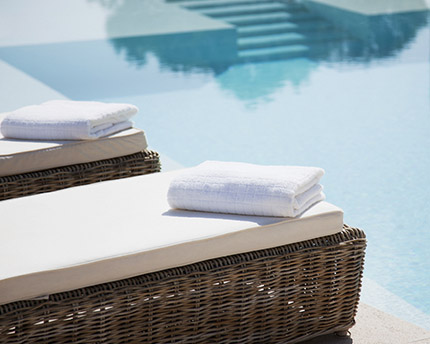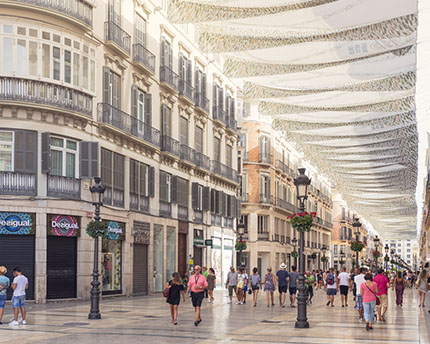Málaga Centro
The Centro district of Málaga is the heart of one of the oldest cities in Europe, founded by the Phoenicians around its port back in the eighth century BC. Made up of over 30 small neighbourhoods, the most important in terms of tourism is the large Centro Histórico [Historic Centre], where vestiges of the civilisations that once dominated the capital of the Costa del Sol still remain: the Greeks, Romans, Moors and Christians. Sandwiched between the Guadalmedina river to the west, the port and the Mediterranean Sea to the south, and the hill of Gibralfaro Castle to the east, the centre is intersected from north to south by the famous Calle Marqués de Larios, a pedestrian shopping street that will serve as a reference point on our adventures. The ever busy thoroughfare connects Plaza de la Marina, on Paseo Marítimo seaside promenade, with Plaza de la Constitución, which has been the city’s main square since medieval times.
The biggest draw of Málaga Centro—which we recommend doing first in order to orientate yourself—is climbing up to the Alcazaba and Gibralfaro Castle, perched on the hill of the same name with panoramic views of the city and the bay. Together they make up a walled fortress from Moorish times that dates back to the eleventh century—although there had been a Phoenician settlement there much earlier—which became known as impenetrable owing to its prolonged resistance to a siege from the Catholic Monarchs in 1487. At its feet is the Roman Theatre of Málaga, another one of the city’s most famous landmarks ever since it opened to the public in 2003. The theatre, which dates back to the first century AD, had gone unnoticed before it was discovered during construction work in 1951.
Another must-visit place along our route is La Encarnación Cathedral, situated in front of Plaza del Obispo and more commonly known as La Manquita [the one-armed lady], due to its unfinished appearance and missing southern tower. When construction began in 1528 the tower had been included in the plans drawn up by the architect Diego de Siloé, however, they never came to fruition due to a lack of funds.
Picasso fans mustn’t miss the opportunity to visit the Picasso Museum, situated in the beautiful Buenavista Palace dating from the sixteenth century. In addition to enjoying an interesting collection of works by the Málaga-born master, you can also hire a guided tour, which will take you to his childhood home, situated on Plaza de la Merced, where the artist played as a child, and the beautiful Santiago Church, where he was baptised. However, it doesn’t stop there in terms of museums, as Málaga has become a great capital of contemporary art at European level over the last 15 years. In addition to the renowned Málaga Centre of Contemporary Art (CAC), which opened in 2003, is the more recent Carmen Thyssen Museum (2011) and the Centro Pompidou Málaga (2013), the first branch of the famous Parisian museum outside of France.
Close to the port area, another must-visit is Atarazanas Market, which has preserved the fourteenth-century Nasrid gateway that was the entrance to the old shipyards. Once in the port, don’t miss a walk along the seafront following Alameda Principal, Paseo de Parque de Málaga and Paseo del Muelle Uno.
And for tapas and al fresco drinks, be sure to note down these recommendations: the central Pasaje Chinitas, the surrounding area of Plaza Uncibay and the most legendary establishment in Málaga: El Pimpi, situated in front of the Roman Theatre.
Nearby plans
Related plans

Conoce los mejores balnearios, spas y baños árabes en Málaga
Ya sea en recoletos balnearios, en evocadores baños árabes o en innovadores spas, la provincia de Málaga nos brinda una amplia variedad de tratamientos terapéuticos a través del agua.

El Museo Ruso de Málaga, una ventana a la cultura rusa en el sur de Europa
Las exposiciones del Museo Ruso de San Petersburgo de Málaga constituyen una oportunidad única para sumergirse en la producción artística del país de los zares.

La calle Larios de Málaga. El corazón comercial de la ciudad
La calle Larios, centro también de la vida social de Málaga, es el punto de partida perfecto para disfrutar de una jornada de compras.


